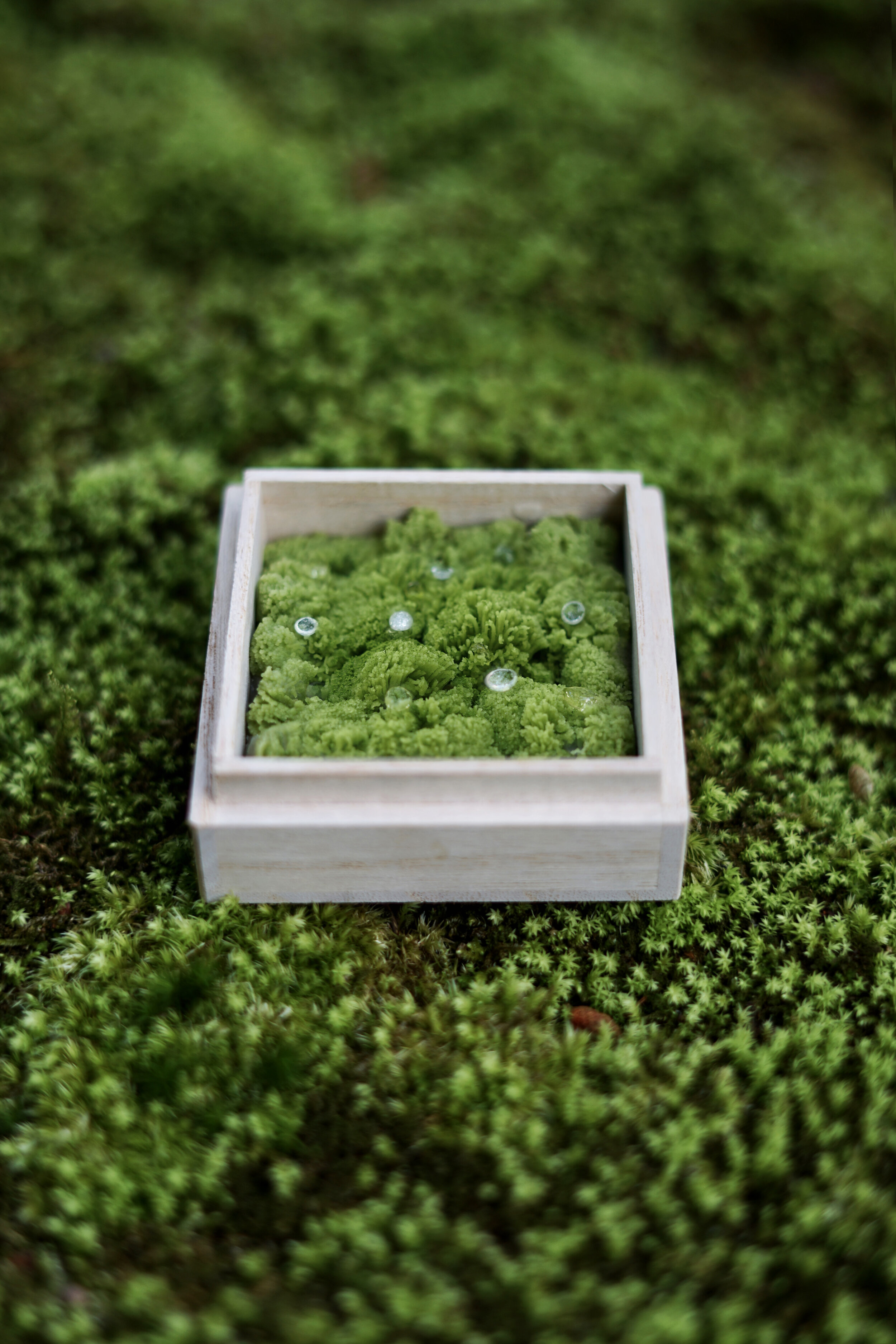
日本庭園を語る上で欠かせない苔。時間と共に朽ち果てていくさまにも美を見出す苔は、日本人の美意識を象徴している。そんな苔庭を、桐箱の中に再現したきんとんの和菓子。
In a Japanese garden, green moss is a symbol of smallness of a human being in contrast to the great nature and the flow of time, as it takes long period of time for moss to cover the entire rocks or ground. This Japanese confectionary represents the Japanese moss garden with morning dews in a wooden box.

ピンと張りつめていた冬の寒さが緩み、時折、風の中に柔らかさを感じる季節。春の訪れを前に、自然と顔もほころぶ様に、固く閉ざされていた花の蕾も徐々にほころび始める。そんな春の到来を予感させる練切の和菓子。
The hash cold loosens its grip and a hint of spring is in the air. Flower buds gradually begin to swell and let us know that spring is just around the corner. This confectionery captures the moment that flower is about to bloom.

古くから農耕で生活してきた日本人にとって、切っても切れない関係の雨。日本語には雨を形容する様々な擬音語がある。ぽつぽつ、ざぁざぁ、しとしと、ぱらぱら…そんな雨模様を可視化した錦玉羹の和菓子です。
Perhaps no other language can be compared to Japanese when it comes to a sensitivity to define nature, especially rain. It is natural to develop different words and onomatopoeia for rain as a rainy country. Potsu-Potsu, Zaa-Zaa, Shito-Shito, Para-para…This confectionery visualized the different types of rain.
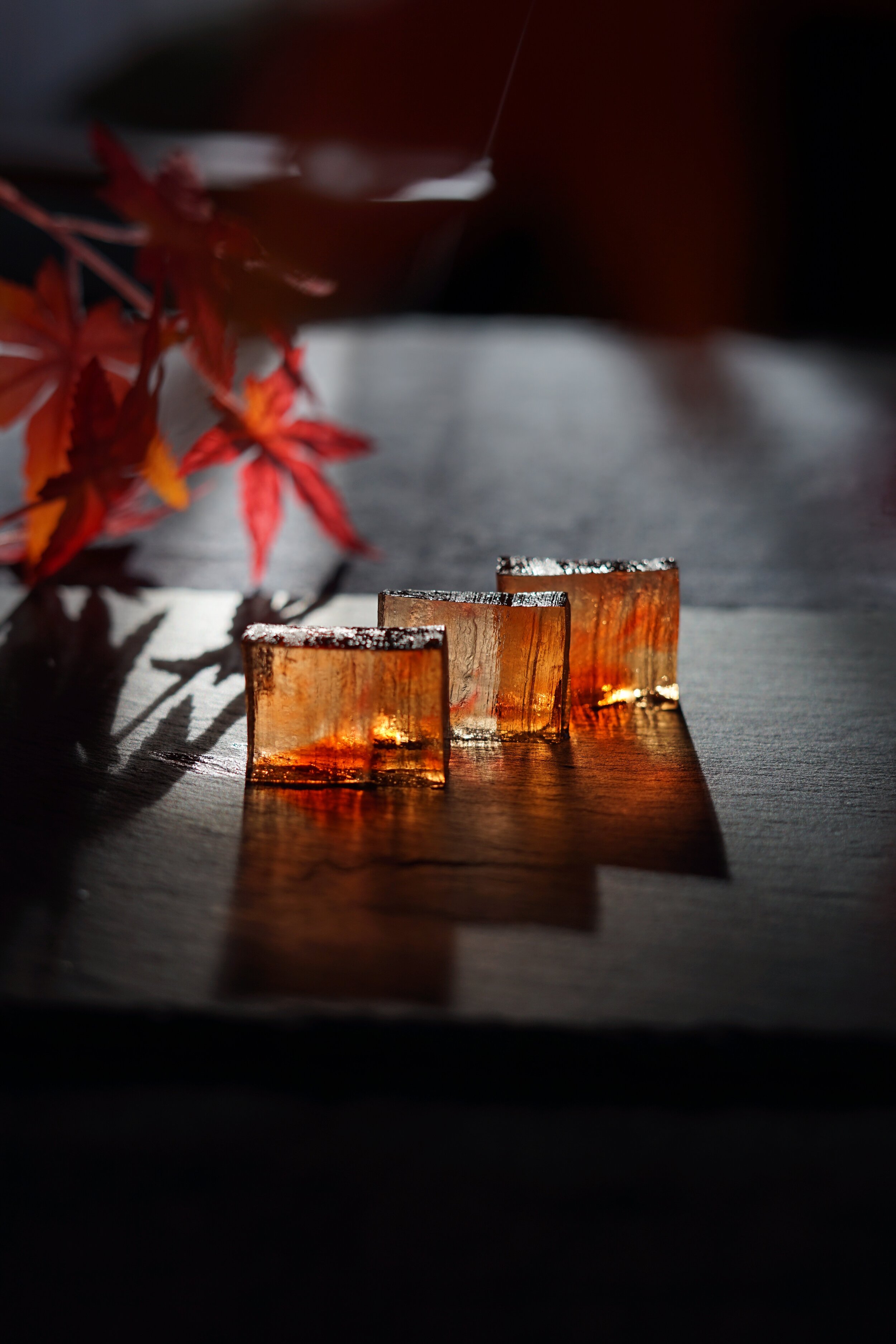
「秋は夕暮れ」と清少納言が評した秋に想いを馳せる。赤く染まった木々に呼応するように、西の空が多彩な茜色に変化する束の間の時。時代は移ろえど、当時と変わらず色づいた紅葉は、見るものの心を魅了し続ける。そんな秋の情景をカタチにした錦玉羹の和菓子です。
"In autumn, dusk is good. Birds flying in a line against a beautiful sunset is good. Small insects singing in the stillness of twilight is also good.” - The Pillow Book: “Makura no Soshi”. Even 1000 year after the poem, beautiful autumn sceneries still capture our minds. This confectionary visualizes the colorful autumn leaves around dusk.

春の到来を告げる花として、黄色の絨毯を敷き詰めたように咲き誇る菜の花をイメージした黄身しぐれ。
The soft breezes that set the stage for springtime tell us that the best time to see the canola flower is approaching. Not only pale pink Sakura, but also bright yellow canola flowers are the symbol of spring in Japan and bring us a sense of invigoration and energy. This confectionary called “Kimi-shigure" represents the beautiful yellow field in spring.

みわたせば 柳桜をこきまぜて 宮こぞ春の 錦なりける
(訳) はるかに都の方を眺めると、柳の緑と桜の紅とを混ぜ合わせた都こそ春の錦であることよ
ピンク色の桜と緑の柳が織りなす春の風景を表現した和菓子です。
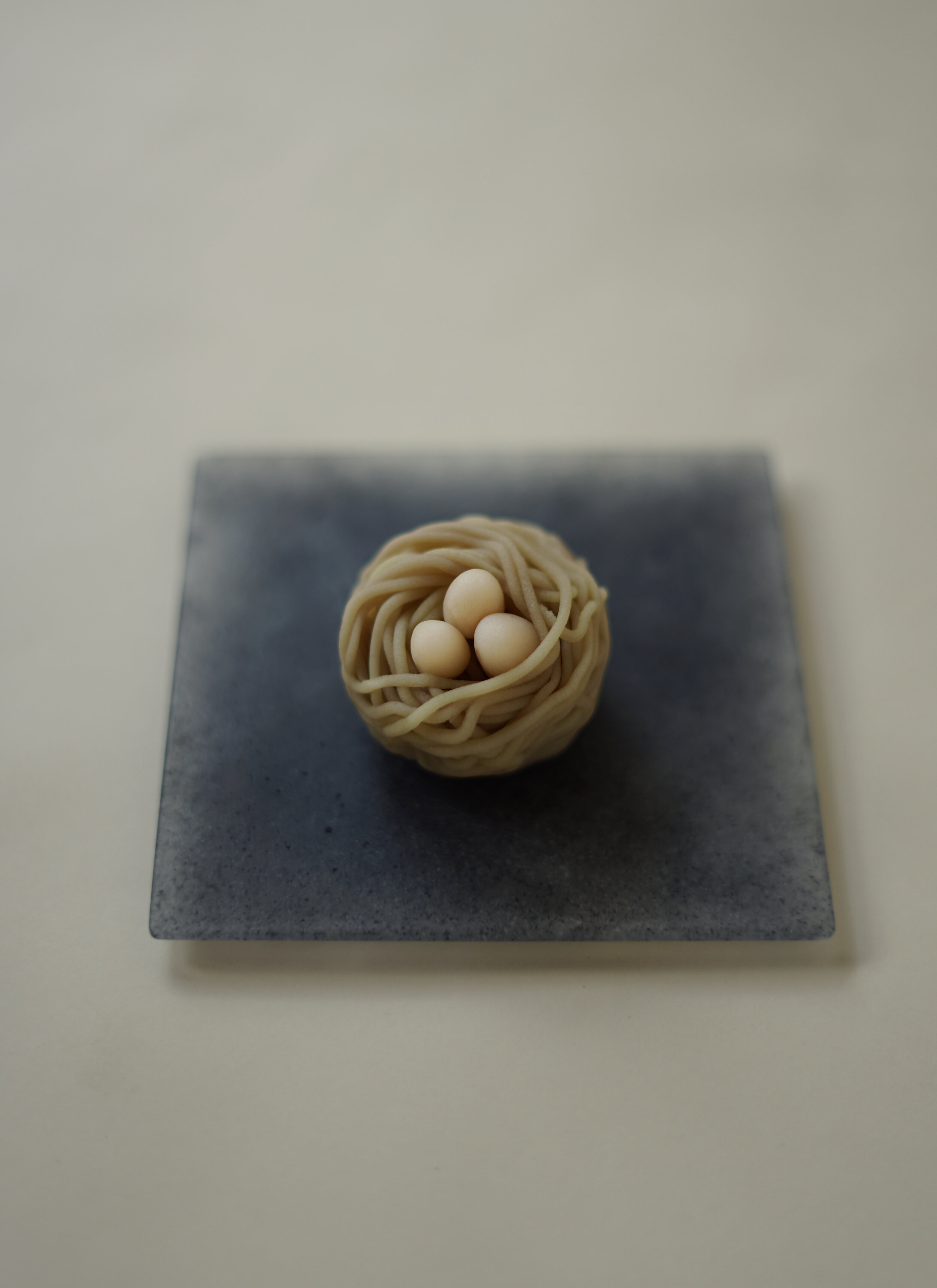
花も虫も、鳥も人も。それぞれに新しい命が宿る場所がある。産み落とされた命を優しく守る、鳥の巣をイメージした和菓子です。
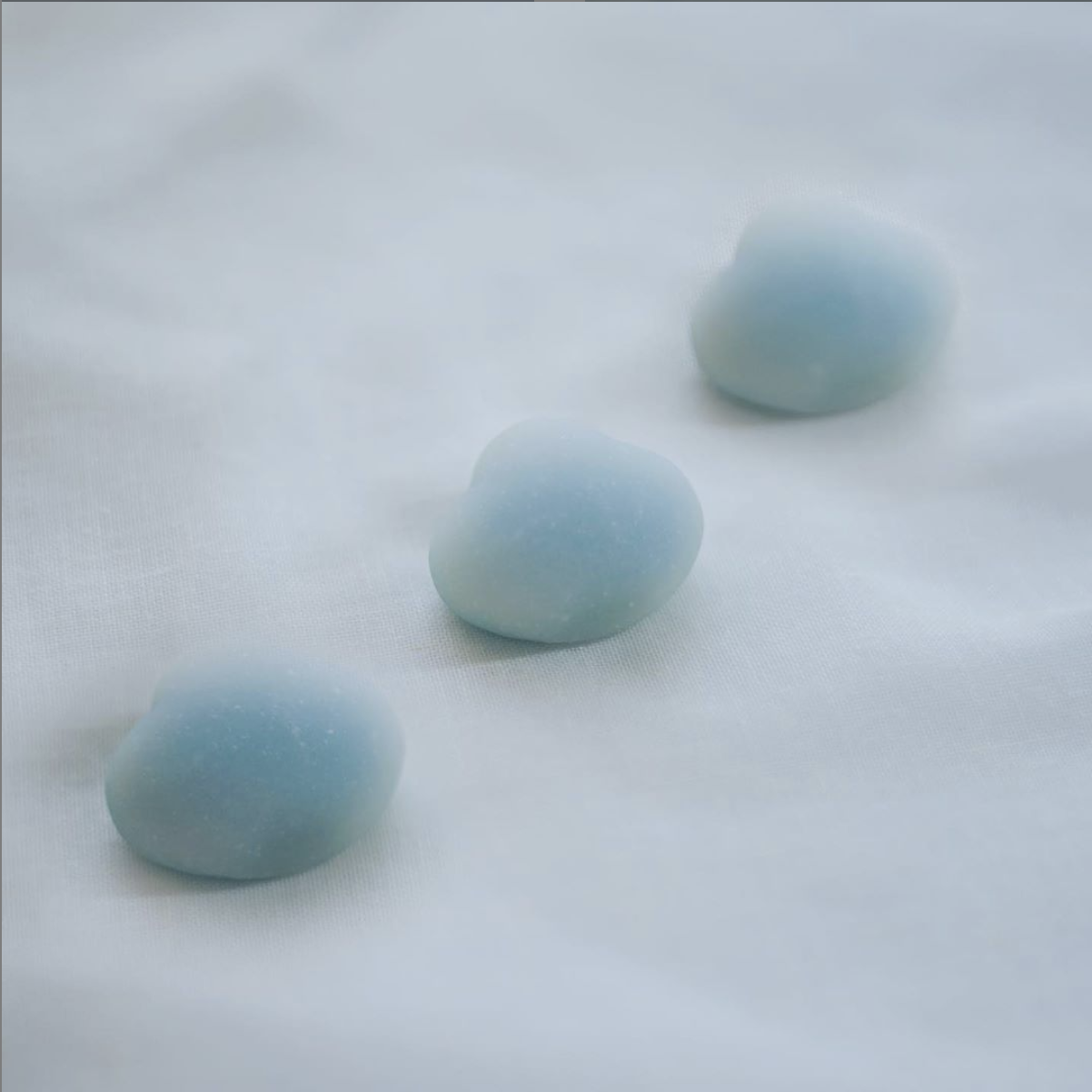
子供の頃に夢見ていた、ふかふかの雲の上でのお昼寝。 そんな柔らかくて、ぷかぷか気持ち良さげに空を漂う、 雲の枕をイメージしたういろうの和菓子。
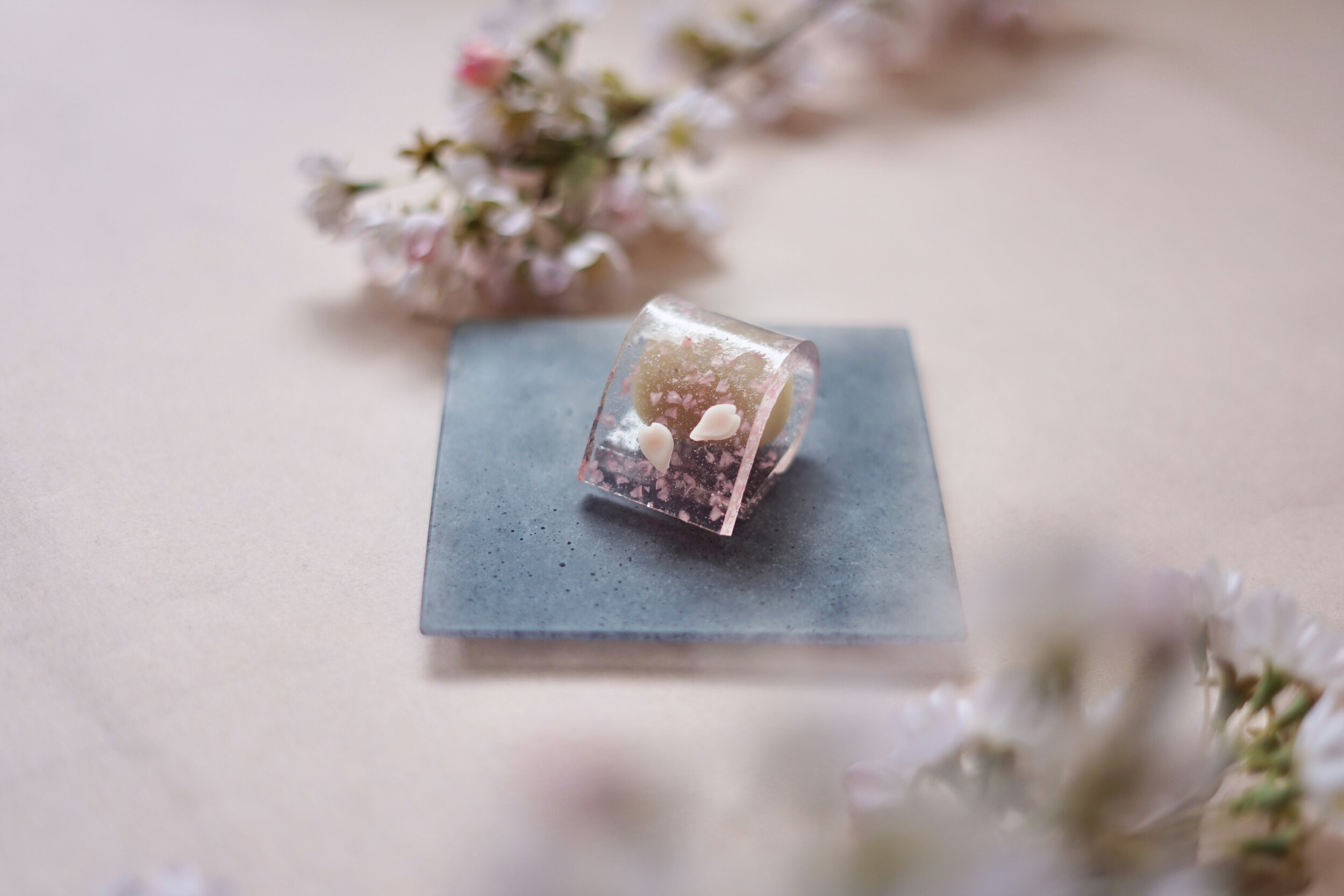
満開に咲いた華やかさもさることながら、散り際もなお美しい桜。ドラマチックに散りゆく桜は、日本の美の理を感じさせてくれる存在。風に吹かれて宙を舞う桜は、まるで春に降る雪のごとし。そんな桜吹雪を描いた和菓子。
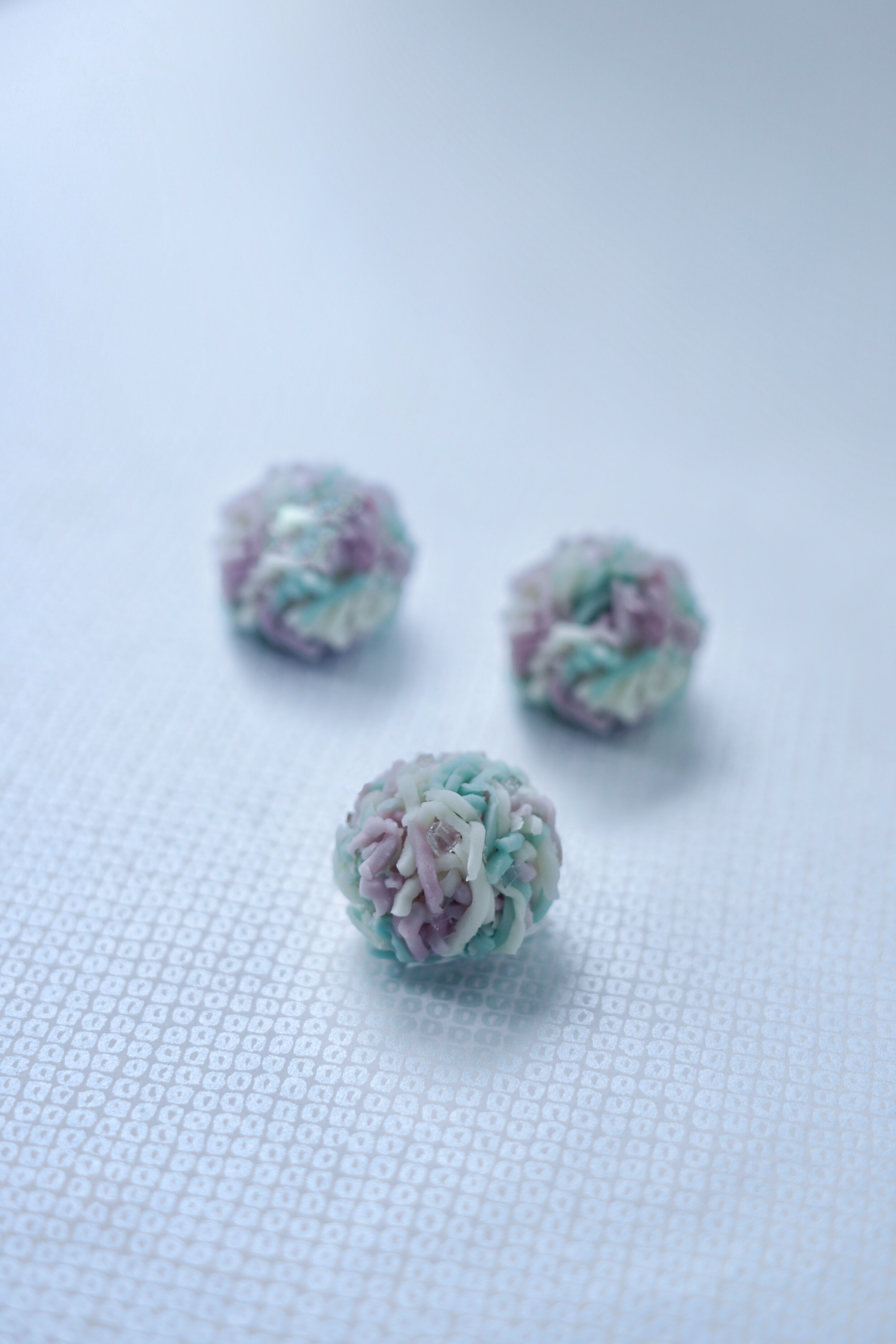
花の色がよく変わることから、「七変化」「八仙花」ともよばれる紫陽花。梅雨の時期、雨露に濡れながら美しく花を咲かせる紫陽花をイメージしたきんとんの和菓子。
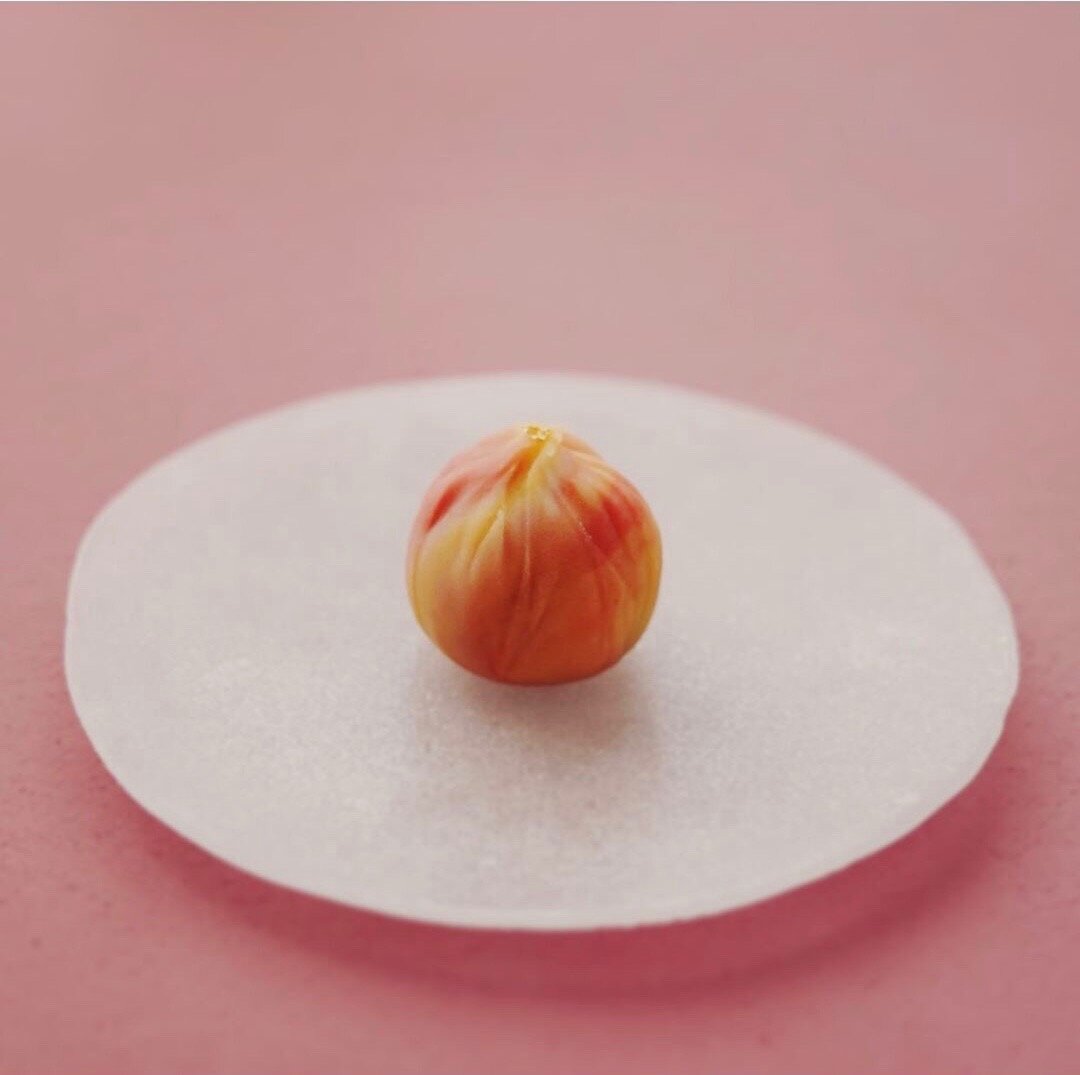
燃える上がる炎のように、一度火がつくと誰にも止めることができない恋。高ぶる感情とは裏腹に、好きな人に想いを伝えられなかった経験は、誰しもが持つ若かりし頃の甘酸っぱい思い出かもしれない。そんな燃えるような恋心を炎に見立てた和菓子。
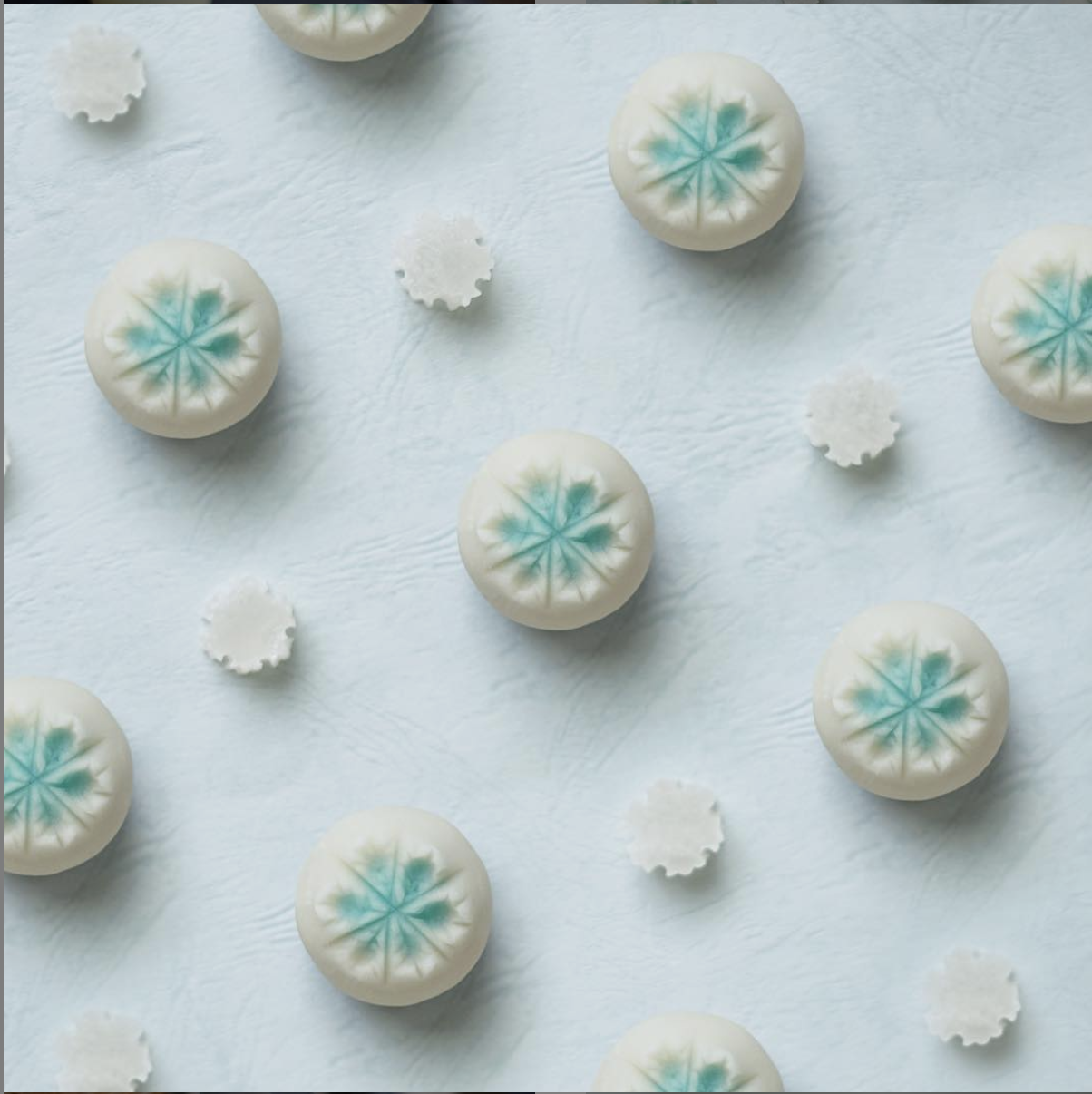
日本では古来より、花に見立てられてきた雪。たしかに、その結晶は花よりも繊細で美しい。
その美しさとすぐに消えてなくなってしまう様から、春が桜なら冬は雪こそが、日本文化を象徴するシンボルなのかもしれない。
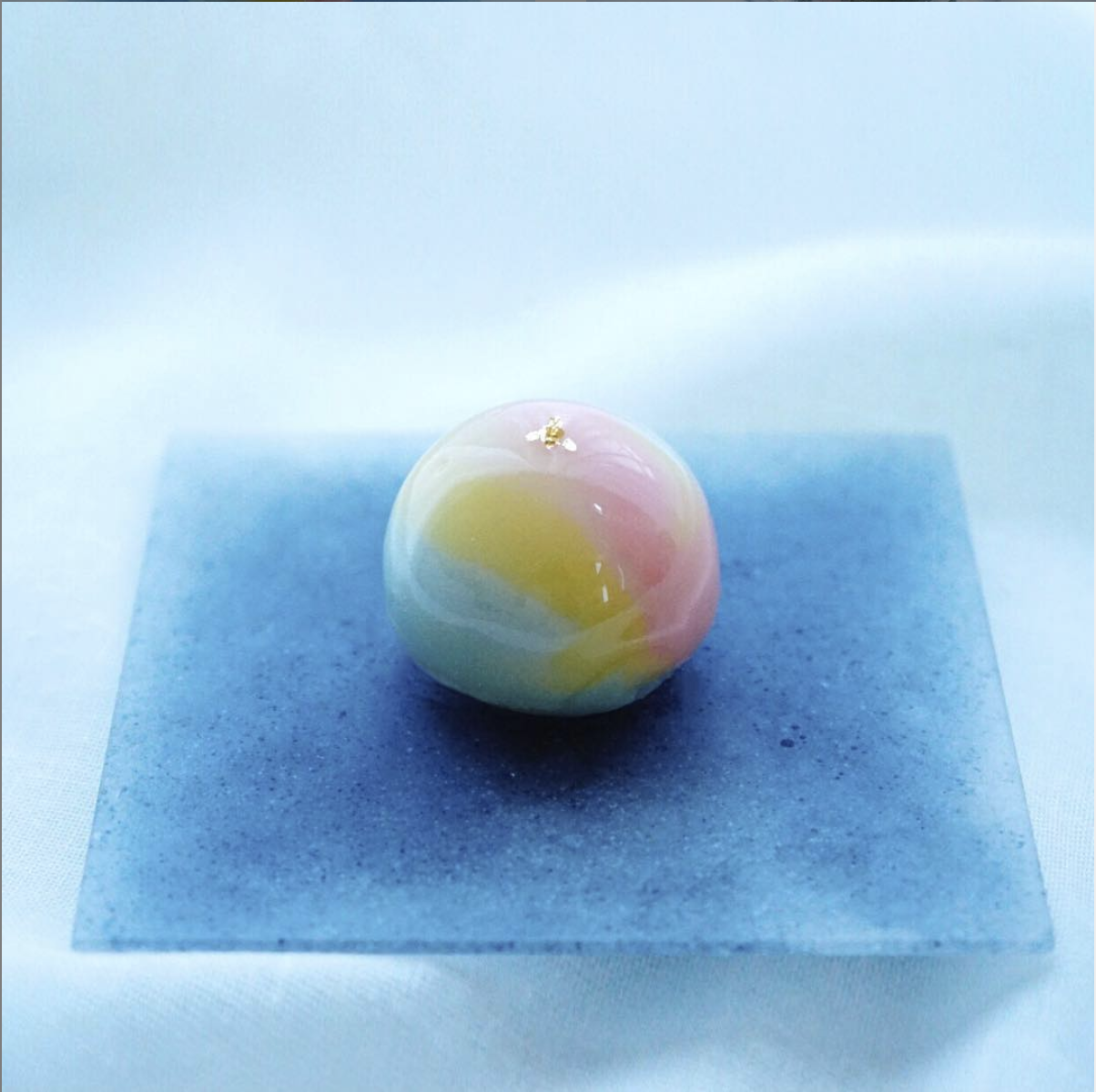
幼い日の夏の記憶を形にした和菓子。
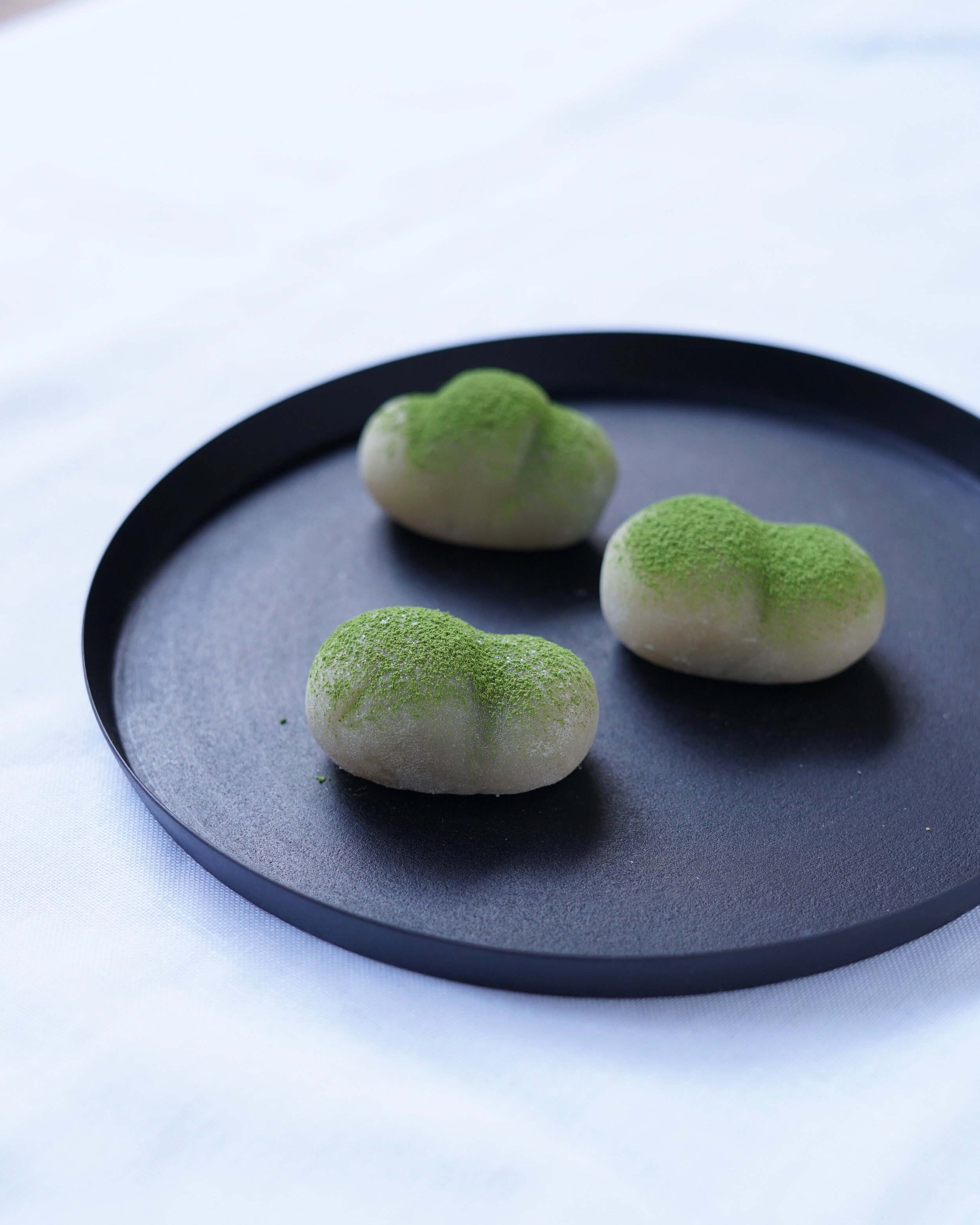
瀬戸内の旅で出会った、のどかな光景。中でも印象に残ったのが、瀬戸内海に浮かぶ島々でした。
そんな海からひょっこり顔を出したような島々をイメージして作った和菓子。瀬戸内の景色を丸ごと召し上がれ。
Through the trip to Setouchi, one of the most impressive sceneries are islands in the Seto Inland Sea.
This confectionary visualizes the islands.














日本庭園を語る上で欠かせない苔。時間と共に朽ち果てていくさまにも美を見出す苔は、日本人の美意識を象徴している。そんな苔庭を、桐箱の中に再現したきんとんの和菓子。
In a Japanese garden, green moss is a symbol of smallness of a human being in contrast to the great nature and the flow of time, as it takes long period of time for moss to cover the entire rocks or ground. This Japanese confectionary represents the Japanese moss garden with morning dews in a wooden box.
ピンと張りつめていた冬の寒さが緩み、時折、風の中に柔らかさを感じる季節。春の訪れを前に、自然と顔もほころぶ様に、固く閉ざされていた花の蕾も徐々にほころび始める。そんな春の到来を予感させる練切の和菓子。
The hash cold loosens its grip and a hint of spring is in the air. Flower buds gradually begin to swell and let us know that spring is just around the corner. This confectionery captures the moment that flower is about to bloom.
古くから農耕で生活してきた日本人にとって、切っても切れない関係の雨。日本語には雨を形容する様々な擬音語がある。ぽつぽつ、ざぁざぁ、しとしと、ぱらぱら…そんな雨模様を可視化した錦玉羹の和菓子です。
Perhaps no other language can be compared to Japanese when it comes to a sensitivity to define nature, especially rain. It is natural to develop different words and onomatopoeia for rain as a rainy country. Potsu-Potsu, Zaa-Zaa, Shito-Shito, Para-para…This confectionery visualized the different types of rain.
「秋は夕暮れ」と清少納言が評した秋に想いを馳せる。赤く染まった木々に呼応するように、西の空が多彩な茜色に変化する束の間の時。時代は移ろえど、当時と変わらず色づいた紅葉は、見るものの心を魅了し続ける。そんな秋の情景をカタチにした錦玉羹の和菓子です。
"In autumn, dusk is good. Birds flying in a line against a beautiful sunset is good. Small insects singing in the stillness of twilight is also good.” - The Pillow Book: “Makura no Soshi”. Even 1000 year after the poem, beautiful autumn sceneries still capture our minds. This confectionary visualizes the colorful autumn leaves around dusk.
春の到来を告げる花として、黄色の絨毯を敷き詰めたように咲き誇る菜の花をイメージした黄身しぐれ。
The soft breezes that set the stage for springtime tell us that the best time to see the canola flower is approaching. Not only pale pink Sakura, but also bright yellow canola flowers are the symbol of spring in Japan and bring us a sense of invigoration and energy. This confectionary called “Kimi-shigure" represents the beautiful yellow field in spring.
みわたせば 柳桜をこきまぜて 宮こぞ春の 錦なりける
(訳) はるかに都の方を眺めると、柳の緑と桜の紅とを混ぜ合わせた都こそ春の錦であることよ
ピンク色の桜と緑の柳が織りなす春の風景を表現した和菓子です。
花も虫も、鳥も人も。それぞれに新しい命が宿る場所がある。産み落とされた命を優しく守る、鳥の巣をイメージした和菓子です。
子供の頃に夢見ていた、ふかふかの雲の上でのお昼寝。 そんな柔らかくて、ぷかぷか気持ち良さげに空を漂う、 雲の枕をイメージしたういろうの和菓子。
満開に咲いた華やかさもさることながら、散り際もなお美しい桜。ドラマチックに散りゆく桜は、日本の美の理を感じさせてくれる存在。風に吹かれて宙を舞う桜は、まるで春に降る雪のごとし。そんな桜吹雪を描いた和菓子。
花の色がよく変わることから、「七変化」「八仙花」ともよばれる紫陽花。梅雨の時期、雨露に濡れながら美しく花を咲かせる紫陽花をイメージしたきんとんの和菓子。
燃える上がる炎のように、一度火がつくと誰にも止めることができない恋。高ぶる感情とは裏腹に、好きな人に想いを伝えられなかった経験は、誰しもが持つ若かりし頃の甘酸っぱい思い出かもしれない。そんな燃えるような恋心を炎に見立てた和菓子。
日本では古来より、花に見立てられてきた雪。たしかに、その結晶は花よりも繊細で美しい。
その美しさとすぐに消えてなくなってしまう様から、春が桜なら冬は雪こそが、日本文化を象徴するシンボルなのかもしれない。
幼い日の夏の記憶を形にした和菓子。
瀬戸内の旅で出会った、のどかな光景。中でも印象に残ったのが、瀬戸内海に浮かぶ島々でした。
そんな海からひょっこり顔を出したような島々をイメージして作った和菓子。瀬戸内の景色を丸ごと召し上がれ。
Through the trip to Setouchi, one of the most impressive sceneries are islands in the Seto Inland Sea.
This confectionary visualizes the islands.
